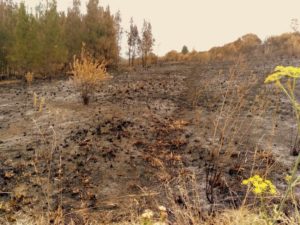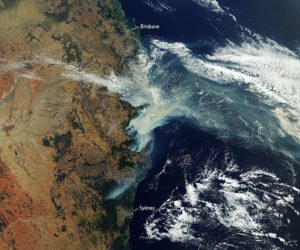 By MIRIAM ACZEL
By MIRIAM ACZEL
Apocalyptic Wildfires
As ‘apocalyptic wildfires’ continue to burn across the Australian Continent, the extent of loss of life is hard to comprehend. Ecologists at the University of Sydney now estimate that over half a billion animals have been killed since the fires first began several months ago, and there is grave concern that entire species have been wiped out. The number of insects and invertebrates—crucial to the functioning of the ecosystem—is immeasurable.
The “mega blaze” has also caused immense damage to infrastructure and homes, forcing hundreds of thousands of people to flee to the shoreline from New South Wales and Victoria. It is estimated that 13 million acres of land have burned, and at least 24 people have been killed, with the death toll rising daily. Since September, 200 wildfires have burned around the 13 million acres, forcing more than 100,000 residents and tourists to flee in one of the biggest evacuations in Australia’s history. Navy ships have been helping to evacuate hundreds of people from beaches along the Australia’s southeastern coast.
Moreover, scientists worry that the worst is yet to come: a group of huge fires – one blaze in the state of Victoria and two others in neighboring new South Wales – currently only six miles apart, could potentially merge within the next few days. According to David Bruce, Victoria’s State Response Controller, “Obviously we have some conditions on Thursday and Friday which will increase the fire danger ratings and, with the potential of these fires joining up, will create some weather conditions that will be very unpredictable and very challenging to fight.”
Once the wildfires reach a ‘critical’ size, the rising heat from the blazes will change the composition of the atmosphere above, thus leading to new and unpredictable weather patterns such as fire tornadoes and dry lightning storms—conditions which can potentially spark new fires ahead of the current fire, causing it propagate even more rapidly.
So how does this relate to climate change?
According to scientists, the wildfires across Australia have been increasing in severity due to climate change, the type of trees catching fire, and extreme weather patterns. 2019 was the hottest and driest year on record in Australia, with the average annual temperature 2.7 degrees Fahrenheit (1.5 degrees Celsius) above the 1960 to 1990 average, according to Australia’s Bureau of Meteorology. Temperatures in Australia last month hit 121.8 F (49.9 C).
Andrew Watkins, the head of long-term forecasts at the Australian Bureau of Meteorology, reported that “What would have been a bad fire season was made worse by the background drying/warming trend.”
Moreover, according to Mike Flannigan, a scientist at the University of Alberta in Canada, “The drier the fuel—trees and plants—the easier it is for fires to start and the hotter and nastier they get, Flannigan said. “It means more fuel is available to burn, which means higher intensity fires, which makes it more difficult—or impossible—to put out,” Flannigan continued.

The aftereffect of the wildfires in Prospect Hill, Sydney (near Pemulwuy and Greystanes) (Photo: Wikimedia Commons: Meganesia)
Indian Ocean Dipole and the Australian Drought
Jeff Beradelli, CBS News meteorologist and climate specialist explained “We’re in a three-year drought in Australia,” and explained that only a few weeks ago, Australia hit 107 degrees as the average temperature, breaking a past record by 3 degrees. Beradelli added that “as a meteorologist, that is remarkable, almost seems like it’s not possible, but it happened.” This long-term drought is caused, in part, because of a typical weather pattern called the Indian Ocean Dipole. However, this year, there has been a record Indian Ocean Dipole, with colder-than-normal water in the eastern part of the Indian Ocean, and warmer water in the western part.
Because of this, Beradelli explained, “we end up with rising air over the western part of the ocean right near Africa. That causes rain. But sinking air, dry air in the eastern part of the Indian Ocean — that causes Indonesia and Australia to dry out.”
Moreover, according to a to a recent study published in Nature, this extreme pattern has been exacerbated by warming temperatures. The total number of extreme heat days in Australia has increased from nearly zero in the years 1910 and 1920 to an average of roughly 15 per year presently, and Australia’s average temperature has increased by roughly 3 degrees Fahrenheit over the past 100 years.
And as The Daily Show host Trevor Noah recently said, “the big thing we’ve got to remember is that unless the world leaders take climate change really seriously, situations like this are just going to keep happening”.

So, what can we do to help?
In the wake of such widespread devastation, it is crucial to do our best to mitigate impacts of climate change—by turning off lights when not in use, biking or walking to work, and educating ourselves and our children about the risks and impacts of a rapidly changing climate.
Additionally, people are asking how they can help support disaster relief in Australia. As even an small amount can help, NBC News has provided a list of a few organizations to consider supporting, reproduced below:
According to NBC, here is a list of reliable organizations to consider, and an explanation of how your support will be used by them:
- Australian Red Cross Disaster Relief and Recovery is raising money to fund recovery programs and emergency assistance in affected communities. Donations also go toward disaster preparation, protection and volunteer training. You can donate here.
- The Salvation Army is also delivering support to communities affected by the fires, with emergency service teams responding to loss of life and property. Make a donation here.
- The St. Vincent de Paul Society helps people who need emergency housing, among many other services, and has launched Vinnies Bushfire Appeal to help families who have been displaced by these fires. You can donate here.
- WIRES is an organization that is committed to rescuing and rehabilitating wildlife rescue in Australia. So many animals have already perished in the fires, but there are survivors who need our help. This organization states on its site that “with the fires destroying unprecedented amounts of habitat, food shortages have increased and lack of suitable habitat will be a significant long-term challenge for surviving wildlife.” Donate to Wires here.
- The World Wildlife Fund (WWF) notes on its site that just five percent of the koala population remains. This number will likely plummet once recovery of the bushfires is underway. The WWF is working to save Australian wildlife and restore land for future habitats. Donate here.
- RSPCA NSW is also working to help animals endangered by the fires, including pets and livestock. You can donate to their bushfire appeal here.
- Vets Beyond Borders is delivering life-saving medical care to animals affected by the Australia bushfires. You can donate here.
- Firefighters are risking their lives to try and put out these flames — many are unpaid volunteers who greatly benefit from our support. Consider a donation to the Country Fire Authority (CFA) in Victoria and the NSW Rural Fire Service in New South Wales. You might also want to hop over on Twitter and search the hashtag, #AuthorsForFireys, where authors are auctioning off signed books, writing services and in some cases, creative input into future projects. The highest bidders must send the agreed upon fee directly to the CFA and show proof of donation.
- Foodbank is a hunger relief charity in Australia. For every $1 donate, they can provide $6 worth of supplies to communities affected by the fires. You can donate here.
- Save the Children is collecting donations to support affected kids by building “child friendly spaces,” where kids can play together and process these changes in a supportive environment. The idea here is to let parents focus on recovery and rebuilding without having to worry about their kids dealing with the additional trauma of loss of community. Donate to Save The Children here.
- One Tree Planted is a 501(c)(3) non-profit based in Vermont. Though the fires are still raging in Australia, the charity is already mapping out ways for long-term restoration. Matt Hill, founder of One Tree Planted, tells NBC News BETTER that as little as $1 can plant a tree, and that going forward in Australia, the organization will work with local groups to establish exactly which kind of trees are needed, since different trees serve different purposes. You can donate here.”



Leave a Reply